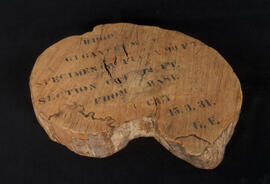Typed transcript of Forrest’s letters and notes.
- Pages 1-28 describe Forrest's journey from Bhamo to Teng Yueh and corresponds closely with a handwritten letter to his fiancée Clementina Traill [GB 235 FRG/1/1/2].
Pages 29-94 contain ‘extractions’ from letters written to Mrs Forrest [either his mother, or Clementina, as she would likely have been Mrs Forrest at the time the letters were transcribed], Edinburgh, from Yunnan and Tibet [1904]-1905. These deal more with descriptions of the country and people rather than botanical matters. The copy letters, which have been typed out of order, are detailed as follows:
-
Pages 29-42. G. Forrest to Mrs Forrest from China Inland Mission, Talifu, 24 March 1905. Describes the valley from Hsia Kuan to Shang Kuan, and gives detailed description of Tali [Dali], its chiefs, main buildings and commerce.
-
Pages 43-53. G. Forrest to Mrs Forrest from China Inland Mission, Talifu, 28 March 1905. Gives further detailed information about Tali. Description of marble quarrying, trades, city buildings, female foot binding, clothing, food, education and customs.
-
Pages 54-63. G. Forrest to Mrs Forrest, November 1904. Describes journey from Tali to Chong Ku on the Chung Tien plateau. ‘I left Tali on the 14th with the intention of going to Lichiang, and from there up to the top of the great Yangtse bend to work the base of the glacier there.’ Includes manuscript sketch of a kitchen or family room of a Tibetan house in which he spent two nights. Detailed description of the house and its use by the Tibetans in winter.
-
Pages 64-67. G. Forrest to Mrs Forrest, November/December 1904. Describes journey from Chung Tien back to Tali, with itinerary.
-
Pages 68-87. G. Forrest to Mrs Forrest, October 1904. Describes a 53-day journey from Tali north into Tibet, covering around 900 miles. Itinerary: Tali, Sha Kai, Shang Ying-pu, Tai Ho Tsun, Sung Kwei, Hoching, Chi Ho, Lichiang, Pei Sha, La Shi Pa, Mu Pi Wan, Na Le, Hsia So Yi, Ke Lo Wan, Mao Niu Chang, Hsia Chung Tien, Yong Ku, Chung Tien, Tang Tien, Chiao Tou, Pung Tzu-la, Kari Pass, Shi zo, Hsia zo, Shih Pa, Yeh Chih, Ba Ti, Tse Kou, Ba Ti, and again Yeh Chih, Ta Chiao, Hsiao Wei Hsi, Ka Ka, Wei Hsia, Lu Tien, Chu Tien, Tzu Ko, Shih Ku, Chia Ho, Chien Chuan-sho, Jiu Kai, Teng Chuan-sho and back to Tali.
-
Pages 88-94. g. Forrest to Mrs Forrest, from Mission Apostolique, Tsekou, Tibet, 28 April 1905. Describes journey from Talifu going north by Chien Chuan and ending at Tsekou. Gives news of a revolt among the lamas in the north, ‘Tsekou is practically in a state of siege.’
Plants referenced:
Bamboo (pp.1,5); Mango (p.1); Orchid (p.6); Rice (pp. 3,16, 20); Teak (p.1)
Cotton (p.41)
Apricot (p.52); Bean (p.52); Cabbage (p.52); Carrot (p.52); Fig (p.52); Filbert (p.52); Gladitschia (p.53); Grape (p.53); Lemon (p.52); Mandarin orange (p.52); Pea (p.52); Peach (p.52); Pear (p.52); Persimmon (p.52); Pomegranate (p.52); Potato (p.52); Rice (p.52); Sapindus (p.53); Turnip (p.52); Walnut (pp.44, 52)
Allium (p.56); Azalea (pp.55, 56, 60); Gentian (pp.55, 56, 60); Lychnis (p.56); Lily (p.58); Paeonia (p.56); Pine (pp.54, 55, 56); Primula (p.60); Rhododendron (pp.55, 56, 60); Saxifrage (pp.56, 57, 60); Senecio (p.57)
Pine (p.66)
Azalea (pp. 77, 82, 85); Carduus (p.77); Clematis (p.80); Fritillaria (p.76); Gentian (pp.76, 77, 85, 87); Lily (p.85); Pine (pp.76, 77); Polygonum (p.77); Primula (pp.76, 82, 85, 86); Rhododendron (pp.77,82, 85); Rice (p.70); Saxifrage (pp.76, 77)
Pine (pp.90, 91)
